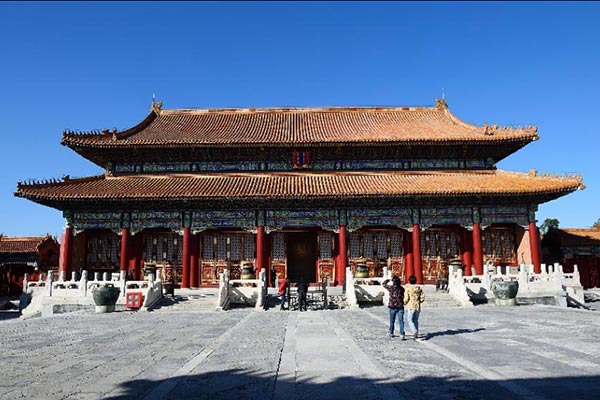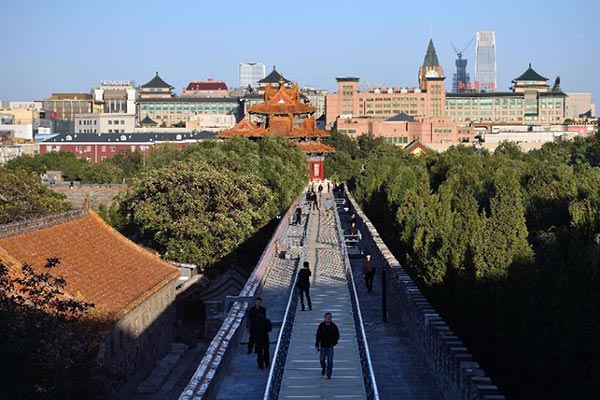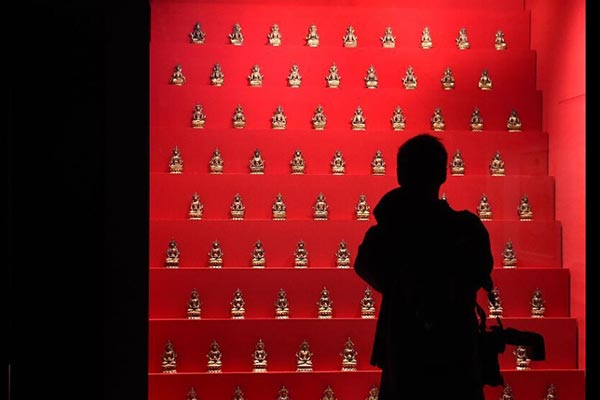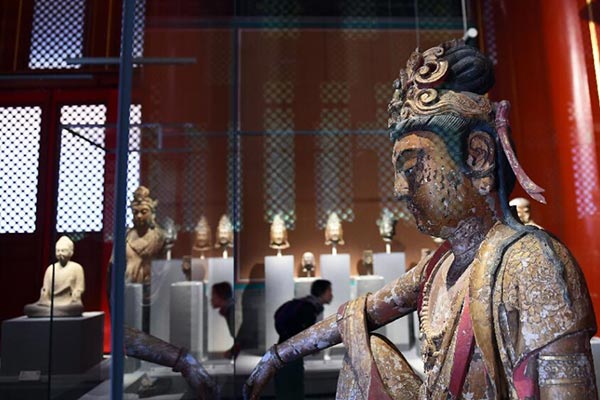
Photo taken on Oct. 8, 2015 shows a building at the new exhibition area which is about to open to public at the Palace Museum in Beijing, capital of China, Oct 8, 2015. The Palace Museum, also known as the Forbidden City, will open four more areas to the public ahead of its 90th anniversary, which is on Oct 10, increasing the opening area of the palace from 52% to 65%. Located in the heart of Beijing, the Forbidden City was home to China’s emperors and was the highest center of power from 1420 to 1911. [Photo/Xinhua]
Four new areas of the Palace Museum, also known as the Forbidden City, will be opened to the public for the first time on Oct 10 since the museum was founded 90 years ago.
They are part of the Cining Palace built mainly for emperors’ mothers and concubines, the Baoyun Building, a warehouse built in 1914 to store thousands of treasures, and wings of the Meridian Gate and East Prosperity Gate.
This increases the areas of the Forbidden City open to the public to 65 percent from 52 percent. The palace, which used to be home to emperors’ families, is about twice the size of the Louvre in Paris.
Shan Jixiang, curator of the Palace Museum, said: “We hope to open more areas of the Forbidden City to allow visitors to see more treasures.”
Of the 1.8 million items in the museum’s collections, less than 1 percent are displayed to the public, Shan said.
Cining Palace (meaning the Palace of Compassion and Tranquillity) in the western part of the Palace Museum used to be home to emperors’ mothers, whose stories have been made into TV series and films.
The newly opened area of the Cining Palace includes a private garden for the mothers, a hall for worshipping the Buddha, and the Shoukang Palace, a residence built for Emperor Qianlong’s mother.
The opening of wings of the Meridian Gate and East Prosperity Gate will enable visitors to walk on the walls of the Forbidden City for the first time.
Shan said restoring the wooden architecture and collections in these buildings required a lot of time and money. Many areas of the Forbidden City are closed to the public when they undergo restoration.
Shan said the target for the next year is for 76 percent of the Forbidden City to be open to the public. Opening more areas is also seen as a way to help relieve congestion, with about 80,000 visitors flocking to the landmark each day.
Eight displays featuring emperors’ treasures will be on view in the newly opened areas to celebrate the 90th anniversary of the Palace Museum. Visitors will not be charged extra to see them.
Shan added: “We hope visitors come to see the Forbidden City more for its displays rather than just for the architecture. Displays tell the stories behind the architecture and what happened hundreds of years ago.”

Photo taken on Oct 8, 2015 shows a brick wall at the new exhibition area which is about to open to public at the Palace Museum in Beijing, capital of China, Oct 8, 2015. The Palace Museum, also known as the Forbidden City, will open four more areas to the public ahead of its 90th anniversary, which is on Oct 10, increasing the opening area of the palace from 52% to 65%. Located at the heart of Beijing, the Forbidden City was home to China’s emperors and was the highest center of power from 1420 to 1911.[Photo/Xinhua]

Photo taken on Oct 8, 2015 shows a brick wall at the new exhibition area which is about to open to public at the Palace Museum in Beijing, capital of China, Oct 8, 2015. The Palace Museum, also known as the Forbidden City, will open four more areas to the public ahead of its 90th anniversary, which is on Oct 10, increasing the opening area of the palace from 52% to 65%. Located at the heart of Beijing, the Forbidden City was home to China’s emperors and was the highest center of power from 1420 to 1911.[Photo/Xinhua]

Photo taken on Oct 8, 2015 shows a building at the new exhibition area which is about to open to public at the Palace Museum in Beijing, capital of China, Oct 8, 2015. The Palace Museum, also known as the Forbidden City, will open four more areas to the public ahead of its 90th anniversary, which is on Oct 10, increasing the opening area of the palace from 52% to 65%. Located at the heart of Beijing, the Forbidden City was home to China’s emperors and was the highest center of power from 1420 to 1911. [Photo/Xinhua]

Photo taken on Oct 8, 2015 shows Buddha statues at the new exhibition area which is about to open to public at the Palace Museum in Beijing, capital of China, Oct 8, 2015. The Palace Museum, also known as the Forbidden City, will open four more areas to the public ahead of its 90th anniversary, which is on Oct 10, increasing the opening area of the palace from 52% to 65%. Located at the heart of Beijing, the Forbidden City was home to China’s emperors and was the highest center of power from 1420 to 1911.[Photo/Xinhua]

Photo taken on Oct 8, 2015 shows a key of a showcase at the new exhibition area which is about to open to public at the Palace Museum in Beijing, capital of China, Oct 8, 2015. The Palace Museum, also known as the Forbidden City, will open four more areas to the public ahead of its 90th anniversary, which is on Oct 10, increasing the opening area of the palace from 52% to 65%. Located at the heart of Beijing, the Forbidden City was home to China’s emperors and was the highest center of power from 1420 to 1911.[Photo/Xinhua]

Photo taken on Oct 8, 2015 shows a Buddha statue at the new exhibition area which is about to open to public at the Palace Museum in Beijing, capital of China, Oct 8, 2015. The Palace Museum, also known as the Forbidden City, will open four more areas to the public ahead of its 90th anniversary, which is on Oct 10, increasing the opening area of the palace from 52% to 65%. Located at the heart of Beijing, the Forbidden City was home to China’s emperors and was the highest center of power from 1420 to 1911.[Photo/Xinhua]

Photo taken on Oct 8, 2015 shows a garden at the new exhibition area which is about to open to public at the Palace Museum in Beijing, capital of China, Oct 8, 2015. The Palace Museum, also known as the Forbidden City, will open four more areas to the public ahead of its 90th anniversary, which is on Oct 10, increasing the opening area of the palace from 52% to 65%. Located at the heart of Beijing, the Forbidden City was home to China’s emperors and was the highest center of power from 1420 to 1911. [Photo/Xinhua]
